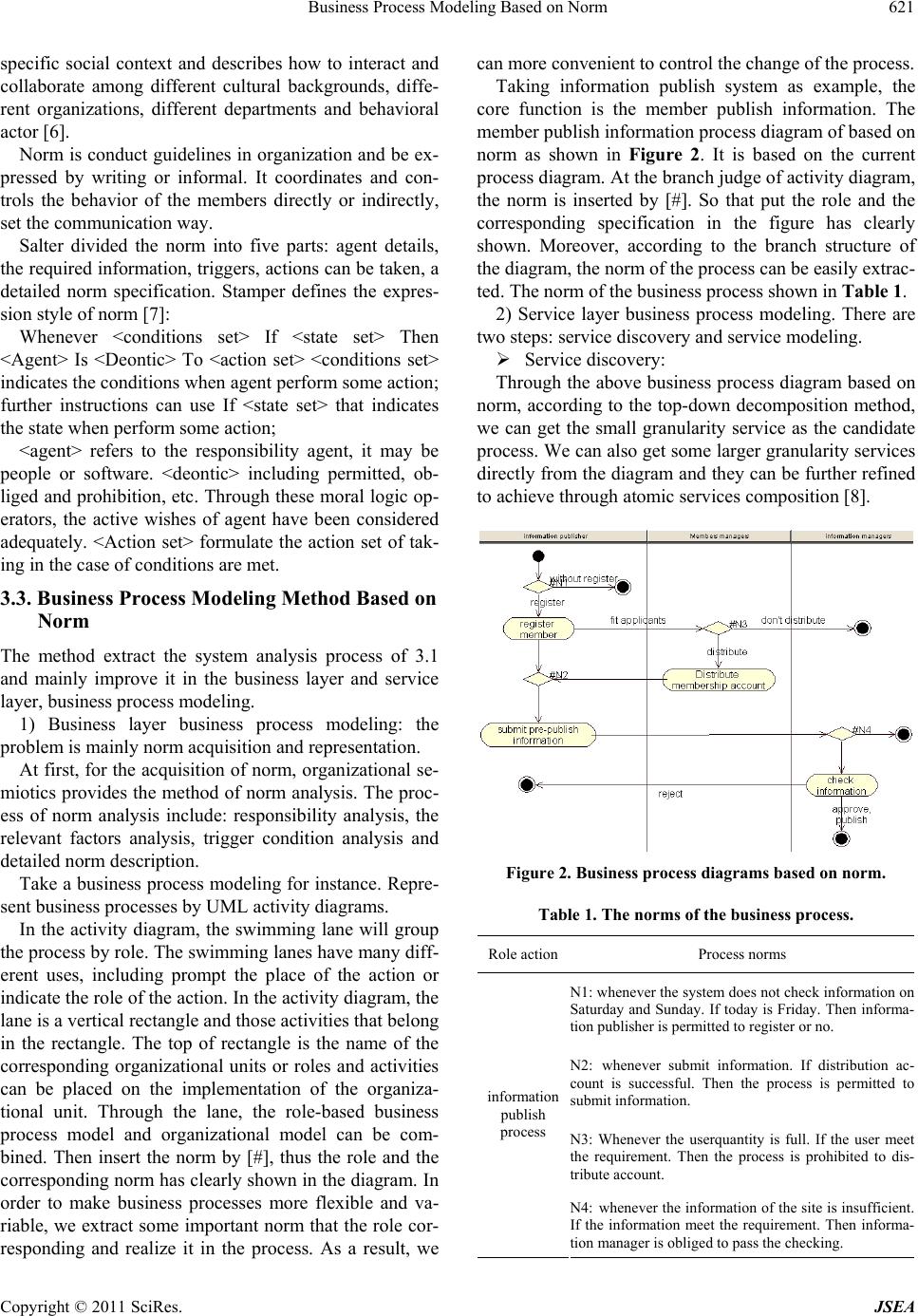
Business Process Modeling Based on Norm621
specific social context and describes how to interact and
collaborate among different cultural backgrounds, diffe-
rent organizations, different departments and behavioral
actor [6].
Norm is conduct guidelines in organization and be ex-
pressed by writing or informal. It coordinates and con-
trols the behavior of the members directly or indirectly,
set the communication way.
Salter divided the norm into five parts: agent details,
the required information, triggers, actions can be taken, a
detailed norm specification. Stamper defines the expres-
sion style of norm [7]:
Whenever <conditions set> If <state set> Then
<Agent> Is <Deontic> To <action set> <conditions set>
indicates the cond itions when agent perform some action;
further instructions can use If <state set> that indicates
the state when perform some action;
<agent> refers to the responsibility agent, it may be
people or software. <deontic> including permitted, ob-
liged and prohibition, etc. Through these moral logic op-
erators, the active wishes of agent have been considered
adequately. <Action set> formulate the action set of tak-
ing in the case of conditions are met.
3.3. Business Process Modeling Method Based on
Norm
The method extract the system analysis process of 3.1
and mainly improve it in the business layer and service
layer, business process modeling.
1) Business layer business process modeling: the
problem is mainly norm acquisition and representation.
At first, for the acquisition of norm, organizational se-
miotics provides the method of norm analysis. The proc-
ess of norm analysis include: responsibility analysis, the
relevant factors analysis, trigger condition analysis and
detailed no rm description.
Take a business process modeling for instance. Repre-
sent business processes by U M L act i vi t y diag rams.
In the activity diagram, the swimming lane will group
the process by role. The swimming lanes have many diff-
erent uses, including prompt the place of the action or
indicate the role of the action. In the activity diagram, the
lane is a vertical rectangle and tho se activities that belong
in the rectangle. The top of rectangle is the name of the
corresponding organizational units or roles and activities
can be placed on the implementation of the organiza-
tional unit. Through the lane, the role-based business
process model and organizational model can be com-
bined. Then insert the norm by [#], thus the role and the
corresponding norm has clearly shown in the diagram. In
order to make business processes more flexible and va-
riable, we extract some important norm that the role co r-
responding and realize it in the process. As a result, we
can more convenient to con trol the change of the process.
Taking information publish system as example, the
core function is the member publish information. The
member publish information process diagram of based on
norm as shown in Figure 2. It is based on the current
process diagram. At the branch judge of activity diagram,
the norm is inserted by [#]. So that put the role and the
corresponding specification in the figure has clearly
shown. Moreover, according to the branch structure of
the diagram, the norm of the process can be easily extrac-
ted. The norm of the business pr ocess shown in Table 1.
2) Service layer business process modeling. There are
two steps: service discovery and service modeling.
Service discovery:
Through the above business process diagram based on
norm, according to the top-down decomposition method,
we can get the small granularity service as the candidate
process. We can also get some larger granularity services
directly from the diagram and they can be further refined
to achieve through atomic services composition [8].
Figure 2. Business proce ss diagrams based on norm.
Table 1. The norms of the business process.
Role actionProcess norms
N1: whenever the system does not check information on
Saturday and Sunday. If today is Friday. Then informa-
tion publisher is permitted to register or no.
N2: whenever submit information. If distribution ac-
count is successful. Then the process is permitted to
submit information.
N3: Whenever the userquantity is full. If the user meet
the requirement. Then the process is prohibited to dis-
tribute account.
information
publish
process
N4: whenever the information of the site is insufficient.
If the information meet the requirement. Then informa-
tion manager is obliged to pass the checking.
Copyright © 2011 SciRes. JSEA